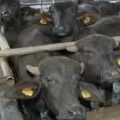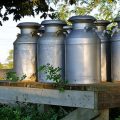Milk is one of the most critical food commodities in the Philippines. About 16% of Filipinos, especially preschoolers and senior citizens, are highly dependent on it. In 2014, local production was 19.73 million liters, of which about 34.77% is supplied by buffaloes (Philippine Statistics Authority, 2015). To achieve a significant increase in milk production, however, the industry needs more genetically improved animals and enhancement of handling and processing efficiency of milk to minimize spoilage and add value to locally produced dairy products.

Dairy buffaloes at the Philippine Carabao Center (PCC) (Photo from PCC)
To improve local milk production, the Philippine Carabao Center (PCC) has introduced village-based buffalo dairying since 1999. Some 54 farmer-cooperatives in Nueva Ecija have been engaged, most of which have federated into the Nueva Ecija Federation of Dairy Carabao Cooperatives (NEFEDCCO). Purebred buffalo dairying was introduced along with crossbred buffalo dairying in selected communities in the country. Despite continuous efforts at improving production, milk yield remain low. In 2014, total milk produced on a once-a-day milking scheme, increased only to an average of 5.13 kg per buffalo.
Several problems were seen to impede milk production performance including mismatch of feeding and level of milk production; asynchrony of ovarian physiology; marked seasonality of production and fertility; silent estrus (heat); incidence of liverfluke, surra, and mastitis; short lactation periods and low milk quality, which impacts on the marketability of the produced milk; and lack of sustainability mechanism for dairy enterprise development.
As the goal is to create sustainable livelihood, promote better nutrition and general well-being of small farmers and ensure stable supply of raw materials for specialty dairy products, the Industry Strategic S&T Program (ISP) on Dairy Buffalo is therefore focused on breeding and genetic improvement, nutrition and feeding, reproduction and health management, milk quality and safety assurance, capability building, and milk-based livelihood and enterprise development.
To address the very slow rate of milk production improvement, a project on Genotyping the Philippine water buffaloes using medium density 90K buffalo SNP panel, has been approved by DOST-PCAARRD and implemented by PCC. Field verification of the phenotypic expression of genetic characteristics related to milk production and application of gene marker technology (SNPs) in breeding and selection are being employed for improved milk production. This will eventually increase milk production by 40%.
Low calf production of only 35% and limited number of cows in the milk line are also problems that the industry has to address. With respect to this, field testing and application of assisted reproduction technologies will be implemented to eventually help milk production at the farm level. With the implementation of these assisted reproduction techniques in 30% of farms, an additional 50% calf production and 50% cows in the milk line are expected.
At the moment, the country’s dairy buffaloes are capable of giving only around 5 li of milk per day. Lactation period is short at 270 days and calf mortality is 10%. S&T gaps seen were on feeding management and calf rearing. To address this, several Community Based S&T-based Farms (CBSTBF) are currently being implemented.
Dairy buffaloes waiting for their turn to be milked in PCC’s Gene Pool facility (Photo from Victor V. Oro)
The CBSTBF on the Use of flushing and supplementation to enhance the carabao-based dairy farms, is being implemented in Leyte and has resulted to an increase in the number of farmers collecting milk as well as higher amount of milk collected from dairy buffaloes. There is also the CBSTBF on the Preparation and utilization of urea-treated rice straw (UTRS) as fodder for dairy buffaloes in Llanera, Nueva Ecija, the CBSTBF on Improving the carabao-based dairy farms in Magdalena, Laguna, and the CBSTBF on Cassava Foliage feeding for dairy buffaloes in Bohol. All these CBSTBFs promote wider adoption of different feeds and milk replacer to ultimately improve milk production at the farm level. Expected from these are an increase in lactation to 300 days, increase in milk production to 7 li/d and increase in calf’s survival rate to 95%.
To improve milk collection and handling and address the current inefficiencies in production to post-production, development of milk collection system, cold storage and milk testing facilities will be implemented soon. These initiatives will develop a milk collection system, introduce cold storage and milk testing facilities and reduce spoilage to 10%. All these combined will help increase the volume of saleable milk and farm income.
To improve milk marketing and distribution, several TechnoMart projects are being implemented thru funding support from DOST-PCAARRD. These are on the Commercialization of grass/forage corn silage for dairy buffaloes in Lupao, Nueva Ecija; TechnoMart on Enhancing the carabao-based dairy enterprise in Magdalena, Laguna and Rosario, Batangas. Under TechnoMart, community cluster milk collection systems are established and farmers are taught means of value-adding, product enhancement, certification and quality testing and commercialization with the hope of establishing a better marketing system for dairy products. These will eventually give higher revenues from milk due to effective and efficient marketing of milk and milk products.
To unify all efforts towards increasing annual milk production of purebred dairy buffaloes in Nueva Ecija from 500,000 kg to at least 2,000,000 kg and of crossbred buffaloes in San Agustin, Isabela from 17,000 kg to at least 190,000 kg over a period of three years, a new program has recently been approved by PCAARRD appropriately titled “Enhancing Milk Production of Water Buffaloes through S&T Interventions.”
Information derived from farmer testing will be the basis for updating PCC’s best practices in dairy buffalo management and for advocating policy programs that will further support and strengthen the local dairy industry.
DOST-PCAARRD will showcase these technologies under its Dairy Buffalo S&T Program, including other agri-aqua science and technology (S&T) outputs on March 2-4, 2016 during the Council’s SIPAG FIESTA at its headquarters in Los Baños, Laguna.
SIPAG, a technology transfer strategy, embodies the Council’s commitment to DOST’s Outcome One in a bid to ensure that the fruits of R&D activities for the agri-aqua sectors will be a blessing for every Juan.







